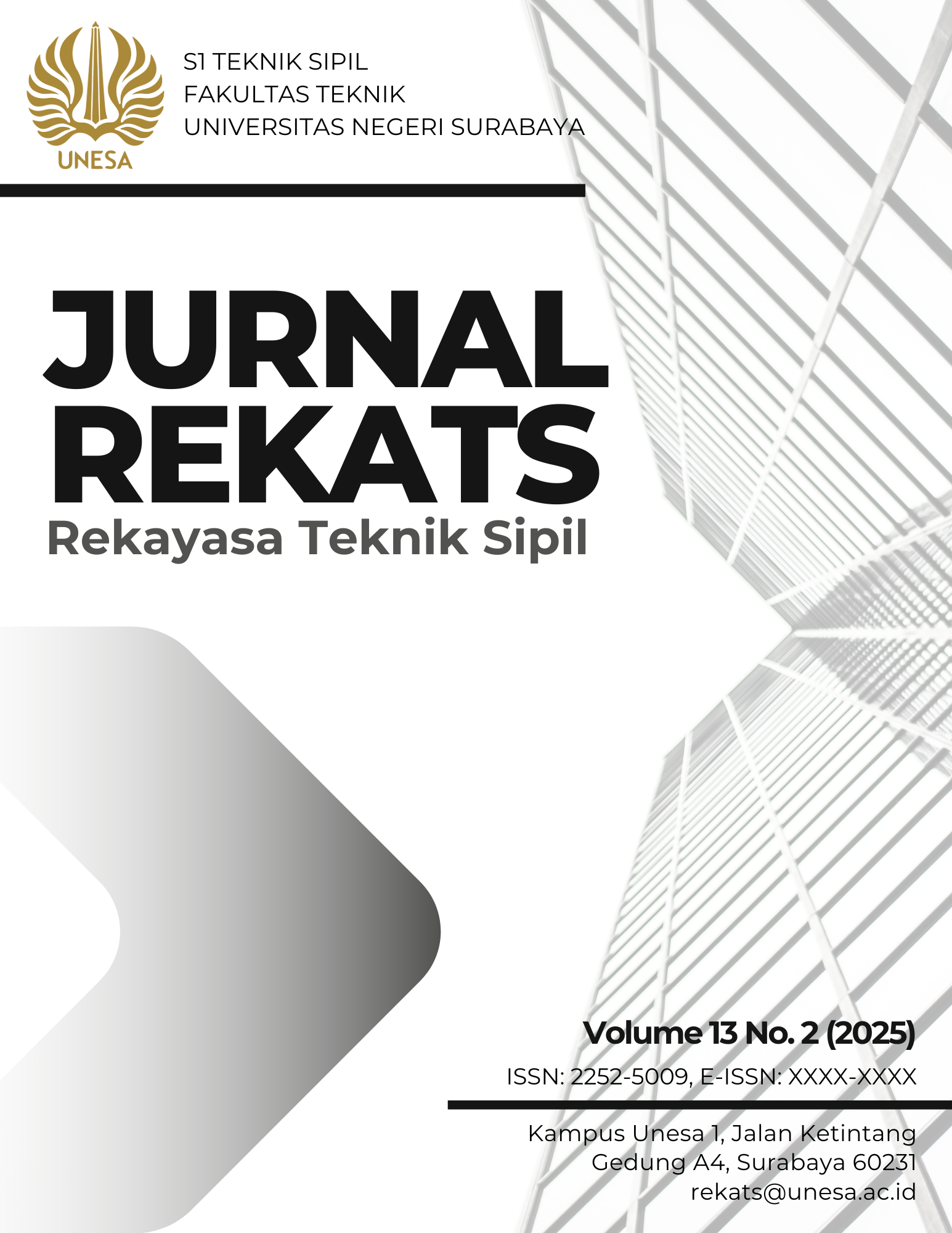ANALYSIS OF CHARACTERISTICS OF WEARING COATING ASPHALT CONCRETE MIXTURE (AC-WC) USING ALUMINIUM SLAG AS FILLER
DOI:
https://doi.org/10.26740/rekats.v13n02.p384-392Keywords:
AC – WC, Filler, Alumunium slag, Parameter Marshall, Spesifikasil Bina MargaAbstract
As a vital component of the transportation system, roads hold a crucial significance across numerous domains such as the economy, society, culture, the environment, politics, and national defense and security. They are also instrumental in the prosperity of communities and the nation. Indonesia features three types of pavement: rigid (concrete), flexible (asphalt), and composite. The essential materials for these pavements include coarse aggregate, fine aggregate, aluminum slag, and asphalt. To establish the Optimum Asphalt Content (OAC), Marshall tests were performed. The results from these tests indicated an optimal OAC of 5.1%. The testing involved a mixture of aggregates, aluminum slag as a filler, and pen 60/70 asphalt. Although some parameters, namely VMA and VFA, did not meet the specified standards, aluminum slag still proved to be the most effective filler at an asphalt content of 5.1% with a 2% inclusion rate.
Downloads
References
AASHTO. (2008). Standard Method of Test for Resistance to Plastic Flow of Bituminous Mixtures Using Marshall Apparatus.
Anggraini, M. (2017). Perbandingan Gradasi Agregat Gabungan Campuran AC-WC Sebelum dan Setelah Penghamparan Dengan Job Mix Formula.
Anggraini, M. (2018). Pengaruh porositas agregat terhadap rongga dalam campuran beraspal panas. Program Studi Teknik Sipil, 4(1), 14–22.
Direktorat Jendral Bina Marga. (2018). Spesifikasi Umum 2018. Divisi 6 Kementerian Pekerjaan Umum Dan Perumahan Rakyat.
Houlík, J., Valentin, J., & Nežerka, V. (2024). Predicting the fatigue life of asphalt concrete using neural networks. arXiv Preprint arXiv:2406.01523.
Jwaida, Z., Al Quraishy, Q. A., Almuhanna, R. R., Dulaimi, A., Bernardo, L. F. A., & Andrade, J. M. de A. (2024). The Use of Waste Fillers in Asphalt Mixtures: A Comprehensive Review. CivilEng, 5(4), 801–826.
Kurniawan, M. F., & Risdianto, Y. (2023). PENGARUH PENAMBAHAN ALUMINIUM SLAG DAN LGA (LAWELE GRANULAR ASPHALT) SEBAGAI BAHAN SUBSTITUSI AGREGAT HALUS PADA CAMPURAN BETON ASPAL LAPIS AUS (AC-WC). Jurnal REKATS Universitas Negeri Surabaya, 11(1).
Nciri, N., Kim, J., Kim, N., & Cho, N. (2016). An in-depth investigation into the physicochemical, thermal, microstructural, and rheological properties of petroleum and natural asphalts. Materials, 9(10), 859.
Parron-Rubio, M. E., Perez-Garcia, F., Gonzalez-Herrera, A., Oliveira, M. J., & Rubio-Cintas, M. D. (2019). Slag substitution as a cementing material in concrete: Mechanical, physical and environmental properties. Materials, 12(18), 2845.
Ramlan, R. (2016). Variasi Komposisi Gradasi Batuan terhadap Karakteristik Beton Aspal dengan Uji Marshall. PENA TEKNIK: Jurnal Ilmiah Ilmu-Ilmu Teknik, 1(1), 1–12.
Rumbyarso, Y. P. A., & Ulum, R. B. (2021). Analisis Pengaruh Penggunaan Cangkang Telur Bebek Ras Petelur Sebagai Filler Pada Campuran Aspal Beton. Jurnal Teknologika, 11(2), 115–124.
Sahara, S., & Saputra, Y. (2023). Pengaruh Transportasi Darat Terhadap Kelancaran Distribusi Logistik. Innovative: Journal Of Social Science Research, 3(6), 8794–8800.
Downloads
Published
Issue
Section
 Abstract views: 44
,
Abstract views: 44
, PDF Downloads: 0
PDF Downloads: 0





